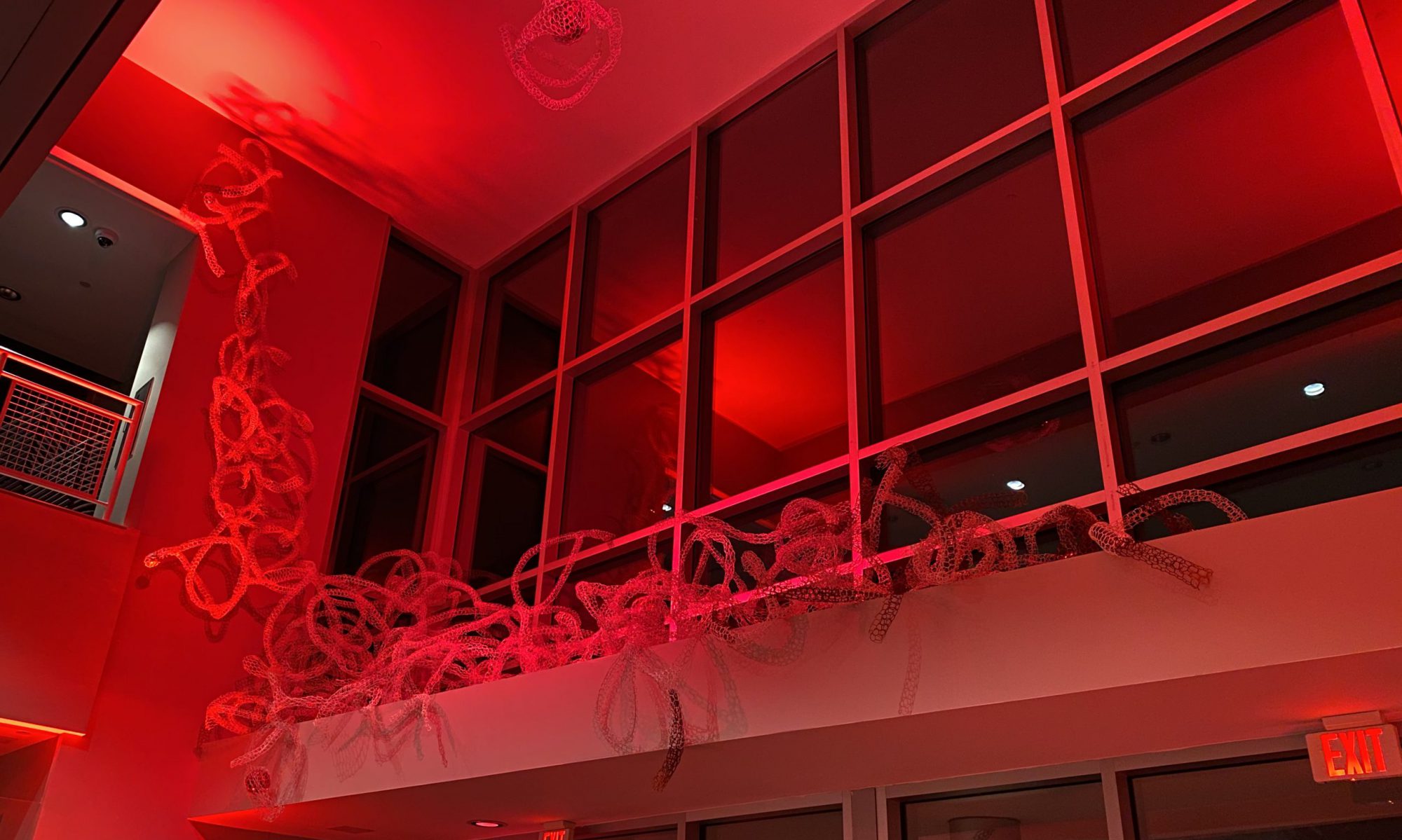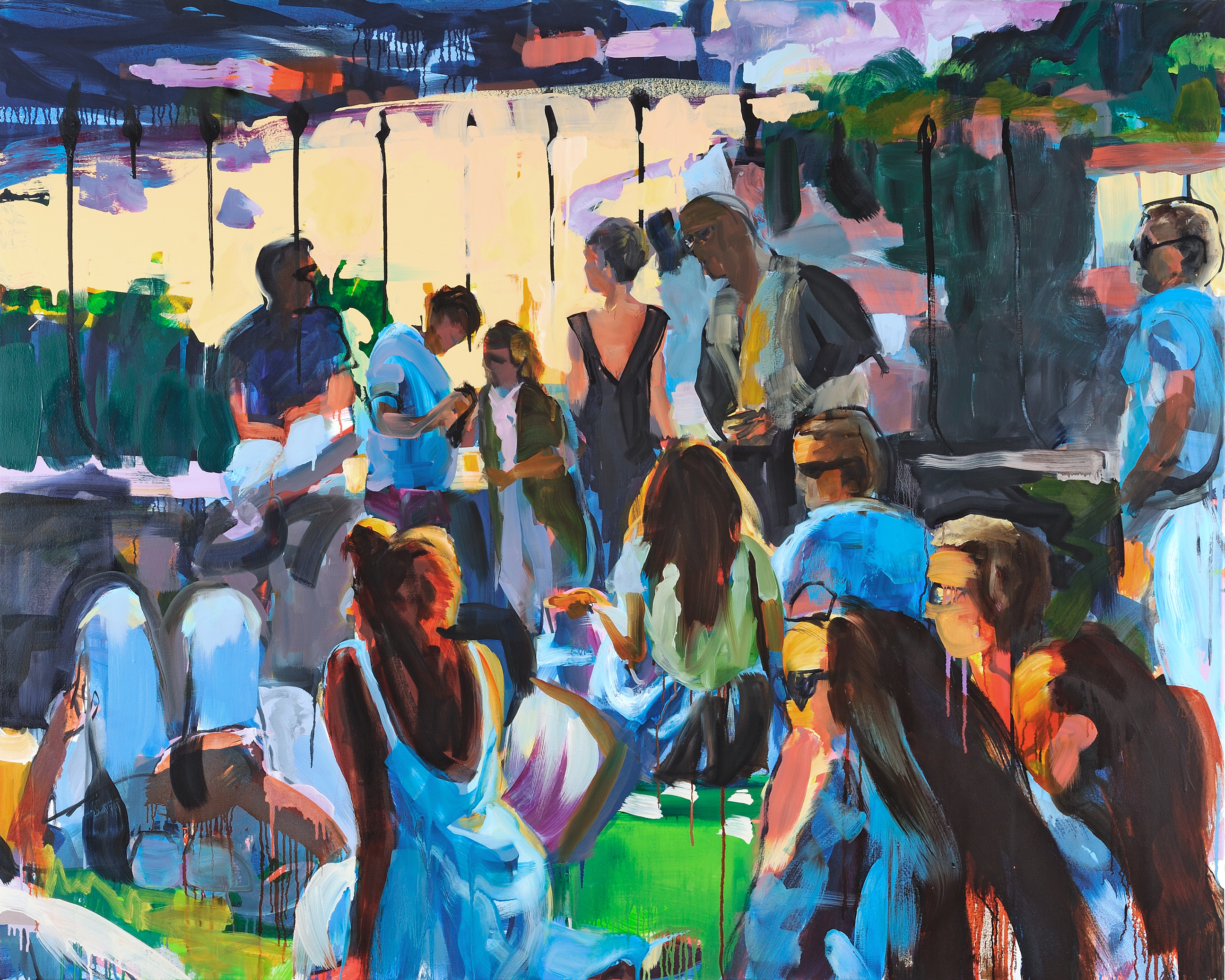Sami Miranda – Sketchbook
Sami Miranda jamming with Pepe Gonzalez, William Knowles, and Mark Merella
Chino Bicicleta Explains His Actions to Spanish Joe
Creative collaboration is integral to Sami Miranda’s art. Please enjoy this video of Sami jamming with Pepe Gonzalez on bass, William Knowles on piano, and Mark Merella on percussion. We also hope that you will visit his online visual art exhibition, We are Always in Conversation: Work by Samuel Miranda.
You can also learn more about Samuel by visiting his website at https://www.samimiranda.com/ and follow him on Instagram at @tres-raices_arts
Email the gallery director, Mary Higgins for inquiries about work in the virtual exhibition.
Online Gallery programs are live!
The Schlesinger and Fisher Art Galleries web programs are live! We have begun an online gallery program. We have started a podcast series – In this Time: Conversations with Artists – that is available on your favorite podcast app as well as on our blog. View the podcast resource pages and visit our first online exhibition We Are Always in Conversation: Works by Samuel Miranda. Join us this Friday on the Fisher Art Gallery Instagram for a Instagram Live poetry reading with Samuel Miranda.
Covid-19 Update – Schlesinger Arts Center – Alexandria Campus
Covid-19 Update
We regretfully announce that all exhibitions have been postponed due to the COVID-19 outbreak. During this crisis, Northern Virginia Community College is following CDC and State of Virginia guidelines and policies.
The Northern Virginia Community College posts updates on the emergency twitch daily on the NVCC COVID-19 page https://www.nvcc.edu/coronavirus/index.html
We wish you good health as you stay at home home during this crisis. Follow the galleries on Instagram @fisherartgallery, Facebook on @fisherartgallery and twitter on @fisherartgallery.
We are planning virtual gallery content during this period of time. We’ll announce on social media . Be Well!
Conduit by Veronica Szalus
A Conversation with Sally Kauffman
A Conversation with Sally Kauffman
Chill Out: Paintings by Sally Kauffman
Artist Talks: November 20, 2019, 5-7PM
Forum Gallery: Schlesinger Arts Center
Northern Virginia Community College – Alexandria Campus
When did you know that you were an artist?
As a child I would sequester myself in a secret spot and draw for hours.
Was there a particular experience that inspired your decision to pursue art?
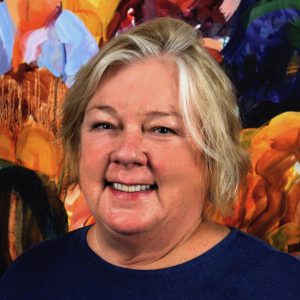 My grandmother taught me to draw and paint as a young girl. One of my favorite memories is sitting by her side watching her paint with watercolors. Her life inspired my own. She was a magical, mystical woman who entertained her family with lavish meals during holidays, especially at Christmas when she dressed as Mrs. Klaus.
My grandmother taught me to draw and paint as a young girl. One of my favorite memories is sitting by her side watching her paint with watercolors. Her life inspired my own. She was a magical, mystical woman who entertained her family with lavish meals during holidays, especially at Christmas when she dressed as Mrs. Klaus.
She owned and operated a therapeutic spa for women as well as an art practice. She painted wonderful images of nature and people. She taught me that I could be whatever I wanted to be.
Are there particular artists or art movements that are an inspiration to you?
Movements and painters amongst the many that influenced my practice from early on include Ukiyo-e artist Hokusai, Venetian School painters Titian, Tintoretto and Veronese, Les Nabis artists Bonnard and Vuillard and Fauvist Matisse. Abstract Expressionism was and remains a major influence. De Kooning, Frankenthaler, Rothko, Pollock, Raushenberg, Johns, Twombly, Mitchell, Krasner, I can’t think of any who did not influence my work. Bay Area Figurative painter Diebenkorn was a revelation to me. Contemporary movements and artists that I currently look at are the YBA (Young British Artists) Cecily Brown, Jenny Saville, Rachel Whiteread and Tracey Emin among many others as well as South African artist Marlene Dumas.
Can you describe your artistic process?
To create the series “Relaxed States” which includes the exhibition “Chill Out”, I discreetly captured images of groups of people lounging and relaxing together using my phone camera. I create digital sketches from the photos by collaging elements and enhancing the color to create a visually dense image. The saturated digital color informs my palette. I mix oil paint and oil painting mediums into a fluid, smooth consistency in small jars, then brush blocks of transparent color directly on the canvas building up multiple layers that afford me flexibility in defining the position and form of the elements. As the forms evolve I respond to the images on the canvas and only reference the digital sketch if I find the need for the original images to inform my own.
Can you talk about how you use visual technologies (computers and software) with your artistic process?
I limit the use of software tools in my creative process to my iPhone and image processing software including Preview, iPhoto and Gimp, all free or shipped with my Mac even though I used many sophisticated tools for 25 years in the tech industry as a user experience designer, graphic designer and art & design director. I’ve resisted integrating digital technology into my art even though I am still fascinated by it, I’m seeking an escape from designing simulated environments and want to live again in the physical world using tangible tools. A good day is when I come home from the studio with paint in my hair and on my face and hands. I use digital tools to create digital sketches in the conceptual phase using snapshots with my iPhone and manipulating the images on the computer. I print the sketches and use them as a reference. The final artwork is produced by hand with paint and canvas.
You have four paintings in the exhibition that were inspired by the summer jazz concerts at the National Gallery in Washington DC. Can you tell us about that experience and what made you want to explore the experience in paint?
 The long answer: after a 20 year hiatus from painting while I worked in the tech industry, I needed inspiration as I resumed my painting practice so I enrolled in a class called “Painting in a Series” at the Corcoran taught by Judy Southerland. Judy reviewed my work and asked me what I was going to paint. I did not know so she gave me a written exercise titled “What Matters” in which you described an activity you care about and how it affects you and others, a social system that interests you and your stance in relation to this system and a condition or question that interests you. I filled it out but still it was unclear to me. So I turned to my private life. My husband and I love to cook and entertain our friends so I started photographing and painting my dinner parties. Out of this grew a series of work centered on groups of people sharing food, swimming and listening to music.
The long answer: after a 20 year hiatus from painting while I worked in the tech industry, I needed inspiration as I resumed my painting practice so I enrolled in a class called “Painting in a Series” at the Corcoran taught by Judy Southerland. Judy reviewed my work and asked me what I was going to paint. I did not know so she gave me a written exercise titled “What Matters” in which you described an activity you care about and how it affects you and others, a social system that interests you and your stance in relation to this system and a condition or question that interests you. I filled it out but still it was unclear to me. So I turned to my private life. My husband and I love to cook and entertain our friends so I started photographing and painting my dinner parties. Out of this grew a series of work centered on groups of people sharing food, swimming and listening to music.
The paintings in the exhibition were inspired by evenings spent sitting in the National Sculpture garden listening to jazz surrounded by the fascinating people who live in DC. I wanted the paintings to celebrate and exude the kind of energy and pleasure that you would find in Manet’s “Le Dejeuner sur l’herbe” and Titian’s painting “The Bacchanal of the Andrians”.
What about your strolls through Porto inspired you? The color and light in the two series of works is very different. How do you use color and light to create the atmosphere in your paintings?
 I visited the Passeio Das Virtudes during the “golden hour” which is the first or last hour of sunlight in a day when the light is soft and warm and the shadows long. This combination of warm colors contrasted with darker cool color defines my typical palette and explains my attraction to the scene.
I visited the Passeio Das Virtudes during the “golden hour” which is the first or last hour of sunlight in a day when the light is soft and warm and the shadows long. This combination of warm colors contrasted with darker cool color defines my typical palette and explains my attraction to the scene.
The paintings inspired from the “Jazz in the Garden” depict the warmer light just before the golden hour. I’m fascinated by paintings that create drama using chiaroscuro, the strong contrast of light or lack of it to define volume in form. Diebenkorn and Hopper’s use of chiaroscuro in their paintings is a good example of this and of course, Caravaggio was the master.
What is that you would like the viewer to take away from their experience of seeing this exhibition?
A collector of a painting in this series recently wrote to me “every time we look at your piece of art we are more delighted.” That is one of the most satisfying aspects of my art practice.
Is there any advice that you would give students as they have made the decision to pursue art?
Define what you want your art practice to be and treat your practice as a profession. This can and will change over time as you mature as an artist and a person. Schedule time for your practice and stick to it even if it involves sitting in your studio and staring at the walls, this is critical to your development. Build a network of your peers by attending local exhibitions and introducing yourself to the artists and gallery owners. Once you have built up that network support your artist friends by attending their art events. Define a social media strategy for yourself. Attend the free lectures at the Smithsonian. Read Art/Work = Everything You Need to Know (and Do) As You Pursue Your Art Career. Rent a studio that hosts open studios and will expose you to other artists and collectors.
To kickstart my art practice after a long hiatus, I studied at the Corcoran in the evenings for 3 years with Judy Southerland who become a mentor for me. (find a mentor) The artists I met in her class are now my peers. I rented studios through which I met different groups of artist friends. I also joined the Studio Gallery, the longest running artist coops in DC, while I had another full-time job. Scheduled annual shows taught me how to prepare and install an exhibit. I learned that I needed to paint when I really didn’t have time or feel like it and how to market my work. I served on the board and learned how to run a gallery. And made more artist friends. I applied for and attended an artist residency at Vermont Studio Center and met an international group of artists. Your network is going to be very important to you. They will expose you to new opportunities and will enrich your practice and life.
What can we expect from your work in the future?
I’m embarking on a big adventure in January. I’m moving to Rome for a year. There are so many things I want to do while I’m there, I’ll be taking workshops, spending lots of time in the museums and galleries and soaking it all in. I’m hoping it will take my work in new directions.
A Conversation with Cathy Abramson
A Conversation with Cathy Abramson
“Dreams of the Underground”
On display in the Margaret W. & Joseph L. Fisher Art Gallery through December 23rd, 2019
Rachel M. Schlesinger Concert Hall and Arts Center
Can you describe your artistic process?
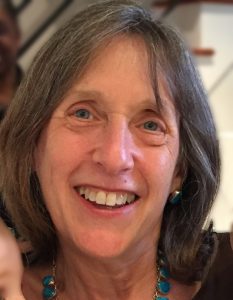 I start by taking photos, lots of photos. I try to carry my camera or iPhone with me and will stop and take a picture if something strikes me as noteworthy, a building in the golden hour, a shadow, people gathered at a public event, a reflection in a window. Often the images won’t make a full composition but have an interesting texture of an element that could be part of a painting. I spend a lot of time thinking about the images I’ve gathered and something will call out to me and then I’ll start composing an image in Photoshop. Frequently this image becomes a small painted color study and if the potential is there for a larger painting, I’ll go ahead and will begin sketching the image in paint on a toned canvas or panel. First I work up a value study and when I’m pleased with the result I add color. I often use squeegees and rollers in addition to my paint brushes to get a desired effect.
I start by taking photos, lots of photos. I try to carry my camera or iPhone with me and will stop and take a picture if something strikes me as noteworthy, a building in the golden hour, a shadow, people gathered at a public event, a reflection in a window. Often the images won’t make a full composition but have an interesting texture of an element that could be part of a painting. I spend a lot of time thinking about the images I’ve gathered and something will call out to me and then I’ll start composing an image in Photoshop. Frequently this image becomes a small painted color study and if the potential is there for a larger painting, I’ll go ahead and will begin sketching the image in paint on a toned canvas or panel. First I work up a value study and when I’m pleased with the result I add color. I often use squeegees and rollers in addition to my paint brushes to get a desired effect.
When did you know that you were in an artist?
I always loved to draw. I never got good grades in art courses but it was just something I loved doing. I needed a job and took illustration and graphic design courses and became an illustrator and art director even though my first degree was in Political Science. One of my first jobs was as an art director at a political magazine and I drew a pretty good Ronald Reagan. One letter to the editor commented on a cartoon I did for the magazine. It said that one of my cartoons was offensive...I knew I was off and running!
When I retired as an art director, I was able to take a 3 year course of master painting techniques at the Compass Atelier in Rockville, get a studio and paint as much as I could. I can now spend a good amount of my time painting.
What are your artistic inspirations? Are there particular artists or art movements that are an inspiration to you?
I’m a representational painter and like the structure of painting something recognizable. I’ve always loved Edward Hopper and my work is often compared to his although I think my paintings are not as lonely and the characters are not as isolated. I’ve always been interested in narrative and looked to illustrators for inspiration. I’ve spent many hours looking at the art of Ben Shahn, Edward Sorel, Ralph Steadman, David Levine, Leonard Baskin and copying their work. As far as painters are concerned, aside from Hopper, there are any number of contemporary painters that I admire: Burton Silverman, Alyssa Monks, Steven Assael, Lucien Freud, any of the California figurative painters.
More recently I’ve been following Alex Kanevsky and David Kassan. Often the last show or artist I’ve seen becomes my new favorite.
Why does the urban environment inspire you over other environments?
I love the activity, interplay of light and shadow, and the sheer mass of architectural forms. Everything is constantly changing in the urban environment and there’s an urgency to really look and see what’s going on. There’s also a need to examine the underlying politics and social interactions and decode what is apparent and what lies just below the surface.
What is it that you hope to capture of your experience in Washington DC and other locations?
Many of my past paintings in the district had to do with neighborhoods and people in transition. Many neighborhoods including the Kennedy Street corridor are being overhauled and there are stories to record and examine. Now I’m interested in the Brutalist buildings in Washington, DC. There’s a gritty beauty in parking garages or the many government buildings that are wall-to-wall slabs of concrete. Believe it or not, even the FBI building has a certain charm. I like to see how people interact with these sterile buildings and think of a narrative for those settings and people.
You have a painting in the exhibition entitled “Cathedral”. What about the subject matter inspired you to call the painting after a type of church?
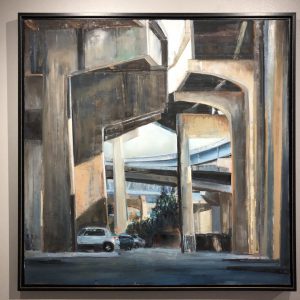
“Cathedral” is an underpass at the beginning of Magazine Street in New Orleans, near the National WWII Museum. I’ve done a number of paintings at this location and there’s the potential for many more. I loved how the light filtered in between the massive highway supports, much like the light filtering through stained glass windows and falling on the columns in a cathedral.
The texture of the concrete and metal are similar to textures found in cathedrals. The parked cars add a human scale to the setting much like the congregants who are dwarfed by the soaring ceilings in a cathedral. The final note is that cars and technology are worshiped in America.
Tell us about the people in your paintings? For example the women that is the subject of “ In her Shadow” or “ Dream of the Underground”
 The woman in “In Her Shadow” is Ms. Vee, Veronica Cooper. She is a force of nature and began her career as one of the first female pullman porters, She has worked as an accountant, seamstress and artist. She owned and operated Culture Coffee on Kennedy Street and opened Culture Coffee Too in Fort Totten a couple of years ago. She is always stylish from her brightly colored glasses to her gold lame pants.
The woman in “In Her Shadow” is Ms. Vee, Veronica Cooper. She is a force of nature and began her career as one of the first female pullman porters, She has worked as an accountant, seamstress and artist. She owned and operated Culture Coffee on Kennedy Street and opened Culture Coffee Too in Fort Totten a couple of years ago. She is always stylish from her brightly colored glasses to her gold lame pants.
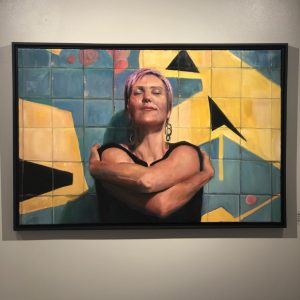
I don’t know much about Sara, the model and dancer in “Dreams of the Underground.” Sara Lavan is the Founder, Executive and Co-Artistic Director of local motion project and was a model the day of a photo shoot and fundraiser that I attended I loved the way she hugged herself and seemed to be wrapped in her own world and dreams. And, what’s not to love about her pink hair.
What is that you would like the viewer to take away from their experience of seeing this exhibition?
I’d like people to come away with a new appreciation for our urban environment, it’s stories and it’s people. Living in a city is a moment to moment experience and I try to isolate a moment, capture it, and move on. These fleeting moments often resonate with the viewer’s own life and narratives. I love to hear the stories the viewers invent on the spot!
Is there any advice that you would give students who have made the decision to pursue art?
It’s very simple, if you love it, do it. Making a living as an artist can be a stretch but you can find a little time here and there for your art. Scale your projects to the time you have available so you don’t get frustrated. If art is important to you make it a priority and expect others to respect your time. Try to schedule time for art just as you schedule time for work, family, friends and all your other interests. Making art can be a joyful, sensual experience and making good art is probably one of the most difficult things you can attempt. The sense of accomplishment you get when you produce something you are proud of is unbeatable.
What can we expect from your work in the future?
I have so many projects and paintings in mind. My next few paintings will be portraits, some personal and some of the women I met while teaching some art classes at a local women’s shelter. I struggle with portraiture and want to get much better. After that it’s back to paintings of DC. I took a number of photos at last year’s Funk Parade and can’t wait to paint from those amazing, colorful images.
November 20, 2019 5-7PM Exhibition Walk Tour Kauffman, Hirons, Abramson
Please join us next Weds evening for a walking tour of our current solo exhibitions with the artist Sally Kauffman, Cathy Abramson and Jean Hirons. They will reach be talking about the work in their solo shows.
CHILL OUT: Paintings by Sally Kauffman

Winter Light: Pastels by Jean Hirons

Dreams of the Underground: Paintings by Cathy Abramson
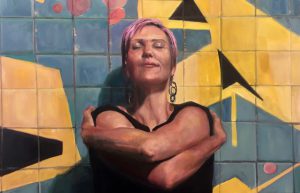
October 19, 2019 2-4PM Art Opening – Sally Kauffman, Jean Hirons, Cathy Abramson and Veronica Szcalus
Please join us on Saturday afternoon October 19, 2019 from 2-4PM for the Final 2019 art openings at the Fisher and Schlesinger Center Art Galleries. We will be celebrating the work of four talented local artists. The artist are Sally Kauffman in the Forum Gallery, Jean Hirons in the Passage Gallery and Cathy Abramson in the Margaret W. & Joseph L. Fisher Art Gallery.
Forum Gallery
Chill Out: Paintings by Sally Kauffman
October 12, 2019 – December 23, 2019
 Kauffman is best known for her abstract yet allusory large-scale paintings that celebrate and exude pleasure. Her gestural brushwork and sensual application of paint reference the figure in landscape. Kauffman draws on personal experiences as a source for her images; Friday Jazz in the Garden concerts at the NGA and recent strolls through Porto provide the setting for the series “Chill Out”. Kauffman captures moments in snapshots and digitally manipulates the composition and intensity of color. The dense, saturated images become the source for the paintings. Almost human scale figures painted in saturated, flowing oil color on large format canvas entice the viewer to engage in their own narrative.
Kauffman is best known for her abstract yet allusory large-scale paintings that celebrate and exude pleasure. Her gestural brushwork and sensual application of paint reference the figure in landscape. Kauffman draws on personal experiences as a source for her images; Friday Jazz in the Garden concerts at the NGA and recent strolls through Porto provide the setting for the series “Chill Out”. Kauffman captures moments in snapshots and digitally manipulates the composition and intensity of color. The dense, saturated images become the source for the paintings. Almost human scale figures painted in saturated, flowing oil color on large format canvas entice the viewer to engage in their own narrative.
Passage Gallery
Winter Light: Pastels by Jean Hirons
October 12, 2019 – December 23, 2019
 Jean Hirons has spent 20 years specializing in the art of soft pastel. Jean’s passion is for the landscape, particularly buildings in the landscape. She began by painting New England houses and rural farms. Since 2015, she has focused on various areas of Washington, DC: Capitol Hill, Georgetown, Chinatown, and Dupont Circle. She finds this subject matter both challenging and satisfying. Composition is always the starting point in any of her paintings and she often looks for abstract shapes. For color, she may use what she sees but, more often, uses color from her imagination. She wants color to be real enough, but not necessarily what was there! Jean also loves complex, broken color and finds pastel to be a perfect medium for achieving this effect.
Jean Hirons has spent 20 years specializing in the art of soft pastel. Jean’s passion is for the landscape, particularly buildings in the landscape. She began by painting New England houses and rural farms. Since 2015, she has focused on various areas of Washington, DC: Capitol Hill, Georgetown, Chinatown, and Dupont Circle. She finds this subject matter both challenging and satisfying. Composition is always the starting point in any of her paintings and she often looks for abstract shapes. For color, she may use what she sees but, more often, uses color from her imagination. She wants color to be real enough, but not necessarily what was there! Jean also loves complex, broken color and finds pastel to be a perfect medium for achieving this effect.
The Passage Gallery exhibit, “Winter Light” displays 6 pastels capturing the moments of one day in winter on the C&O Canal in Washington DC.
Margaret W. & Joseph L. Fisher Art Gallery
Dreams of the Underground: Oil Paintings by Cathy Abramson
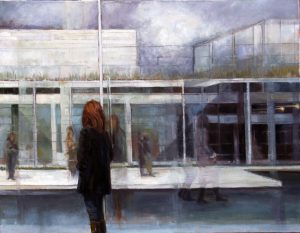 Cathy Abramson’s oil paintings investigate the stories of the city. These representational paintings examine the emotional subtext of change; the connections or estrangement of people in transitional neighborhoods. She sees moments of poetry in the ordinary. Although she paints particular people and scenes, these paintings about daily life in Washington, DC resonate with everyone. Cathy spent two years investigating and painting the neighborhood and people around Kennedy Street, NW. She recorded scenes that are about recent history, change, nostalgia and social struggle; the joys and frustrations of contemporary urban life.
Cathy Abramson’s oil paintings investigate the stories of the city. These representational paintings examine the emotional subtext of change; the connections or estrangement of people in transitional neighborhoods. She sees moments of poetry in the ordinary. Although she paints particular people and scenes, these paintings about daily life in Washington, DC resonate with everyone. Cathy spent two years investigating and painting the neighborhood and people around Kennedy Street, NW. She recorded scenes that are about recent history, change, nostalgia and social struggle; the joys and frustrations of contemporary urban life.
